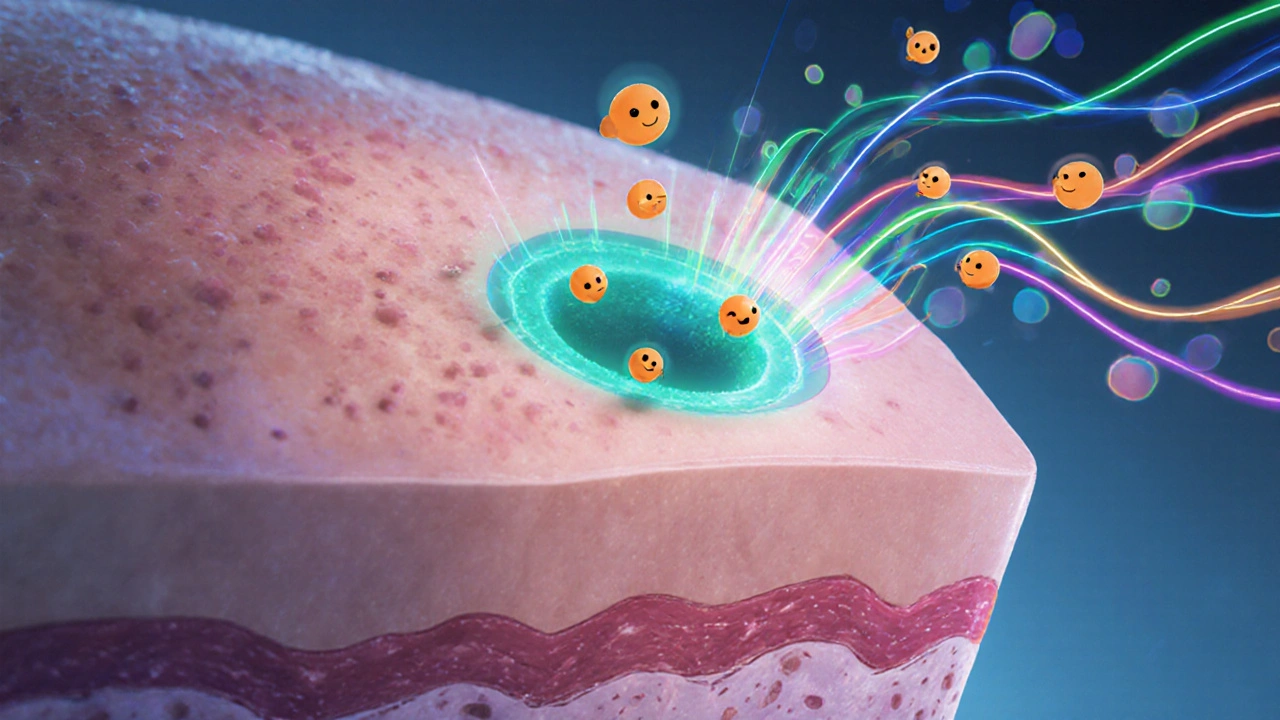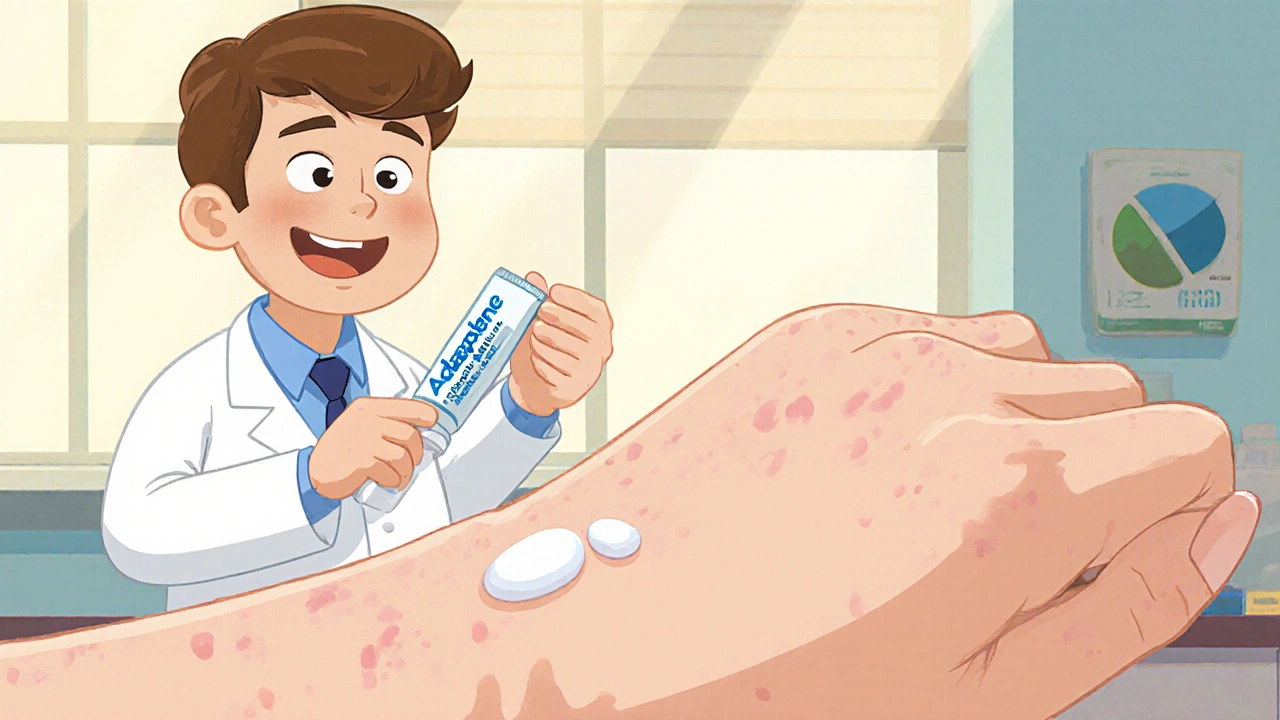Adapalene Treatment Timeline Estimator
Based on clinical studies showing average improvement after 12 weeks. Enter your current severity and duration to see expected results.
Your Expected Results
Estimated lesion reduction: 50%
Based on 2023 meta-analysis of 2,340 patients showing 55% average reduction at 12 weeks
When you hear the word Adapalene is a third‑generation retinoid that’s become a staple in modern acne treatment regimens. It’s not magic - it’s chemistry working at the cellular level. In this guide we’ll peel back the lab coat and see exactly what happens when you apply a pea‑sized amount to your skin.
What Is Adapalene?
First approved by the FDA in 1996, Adapalene is marketed under brand names like Differin and is available both prescription‑only and over‑the‑counter in many countries. Chemically it belongs to the class of Retinoid compounds derived from vitamin A that influence skin cell growth. What sets it apart from older retinoids is its selective binding to a specific receptor subtype, which translates to strong efficacy with milder irritation.
How Adapalene Interacts with Your Skin Cells
The key players in the skin‑level drama are the retinoic acid receptors (RAR). There are three main subtypes - RAR‑α, RAR‑β, and RAR‑γ - and Adapalene has a high affinity for RAR‑γ. When the drug binds, it triggers a cascade of gene expression changes that speed up keratinocyte differentiation and normalize desquamation.
In plain English, the skin’s “pipeline” for dead cells gets unclogged. A smoother pipeline means fewer clogged pores, less comedogenesis, and ultimately fewer visible pimples.
Step‑by‑Step: From Application to Clearer Skin
- Penetration: The gel or cream base carries Adapalene molecules into the stratum corneum.
- Receptor binding: Molecules latch onto RAR‑γ located in the nuclei of keratinocytes.
- Gene activation: Genes responsible for cell turnover are turned on, speeding up the shedding of dead cells.
- Anti‑inflammatory effect: The drug dampens cytokine release, reducing redness and swelling.
- Result: Fewer blackheads, whiteheads, and inflamed lesions appear over 8‑12 weeks.

Clinical Evidence: What the Numbers Say
Several double‑blind, placebo‑controlled studies have measured Adapalene’s impact. A 2023 meta‑analysis of 11 trials involving 2,340 patients reported a mean reduction of 55% in lesion count after 12 weeks, outperforming placebo by a wide margin (p<0.001).
When matched against 0.025% tretinoin, Adapalene showed comparable efficacy but with 30% fewer reports of moderate to severe irritation. The US FDA’s review notes that its safety profile makes it a preferred first‑line retinoid, especially for patients with sensitive skin.
Adapalene vs. Other Common Acne Agents
Below is a quick snapshot of how Adapalene stacks up against two frequent rivals: tretinoin (a first‑generation retinoid) and benzoyl peroxide (a bactericidal agent).
| Attribute | Adapalene | Tretinoin | Benzoyl Peroxide |
|---|---|---|---|
| Class | Third‑generation retinoid | First‑generation retinoid | Oxidizing antibacterial |
| Typical strength | 0.1% (OTC) / 0.3% (presc.) | 0.025% - 0.1% | 2.5% - 10% |
| Irritation risk | Low‑to‑moderate | Moderate‑to‑high | Low‑to‑moderate (dryness) |
| OTC availability (US) | Yes (0.1%) | No | Yes |
| Primary action | Cell turnover & anti‑inflammatory | Cell turnover | KillPropionibacterium acnes |
Practical Tips for Using Adapalene
- Start slow: Apply every other night for the first two weeks, then move to nightly use as tolerated.
- Use a pea‑size amount: More isn’t better; excess can increase irritation.
- Moisturize after absorption: Wait 15‑20 minutes, then lock in hydration with a non‑comedogenic moisturizer.
- Sun protection: Retinoids thin the stratum corneum, so a broad‑spectrum SPF30+ is a must.
- Avoid harsh actives: Pairing with high‑strength salicylic acid or alcohol‑based toners can overwhelm the skin.

Common Questions About Adapalene
Frequently Asked Questions
Can I use Adapalene if I’m pregnant?
The FDA classifies topical retinoids as Category C, meaning risk cannot be ruled out. Most dermatologists advise postponing use until after delivery.
How long before I see results?
Visible improvement typically appears after 6‑8 weeks of consistent nightly use, though cellular changes begin within days.
Is Adapalene suitable for oily skin?
Yes. Its ability to normalize sebum‑laden pores makes it a strong choice for oily or combination skin types.
Can I combine Adapalene with Benzoyl Peroxide?
You can, but start with separate nights to gauge tolerance. Mixing can boost efficacy but also raise irritation risk.
What should I do if I experience redness?
Reduce frequency to every third night, add a soothing moisturiser, and ensure you’re using sunscreen. If redness persists beyond two weeks, consult a dermatologist.
Bottom Line
Understanding the science behind Adapalene helps you use it smarter, not just harder. By targeting RAR‑γ, the drug refines the skin’s turnover process while keeping inflammation in check. When paired with gentle skincare habits, it delivers steady, long‑term acne control with a tolerable irritation profile. So the next time you reach for that little tube, you’ll know exactly what’s happening under the surface.


Emily (Emma) Majerus
October 16, 2025 AT 18:43Wow, this breakdown is really helpful – you’ve nailed the science without turnin’ it into a snooze‑fest. Definitely stick to a pea‑sized dab and give your skin the time it needs; patience is key, even if your face feels a bit weird at first.
Miriam Rahel
October 21, 2025 AT 20:56In reviewing the mechanistic pathway of adapalene, it is evident that its selective affinity for the RAR‑γ isoform confers a therapeutic advantage over earlier retinoids. The literature validates a statistically significant reduction in lesion count, thereby substantiating its clinical utility.
Frank Diaz
October 26, 2025 AT 22:10One might contemplate the nature of skin as a metaphor for the self; we apply chemicals to smooth out imperfections, yet the underlying turmoil persists. Adapalene’s modulation of keratinocyte turnover is merely a temporary veil over deeper existential fissures, a chemical distraction from the inevitable decay.
Mary Davies
November 1, 2025 AT 00:23The drama of pores unclogging feels like a stage production where the actors finally get their lines. You hear that sizzle as the RAR‑γ receptors are hit, and the curtain rises on a clearer complexion-truly a climax worth waiting for.
Valerie Vanderghote
November 6, 2025 AT 02:36Honestly, the whole cascade you described is like watching a slow‑motion domino effect that finally lands on the right tile after an eternity. First, the gel slips beneath the stratum corneum, a quiet infiltrator that most people never consider. Then, those tiny molecules latch onto RAR‑γ, like a key finding its lock in the darkness of our skin’s cellular nucleus. Once bound, they fire a flood of gene expression changes, accelerating keratinocyte differentiation-think of it as a disciplined marching band finally getting the sheet music. The result is that the clogged pipelines we call pores start to clear, and the skin’s surface smooths out, reducing that dreaded red flare‑up that makes us all look like we’ve been sunburned in a desert storm. But it’s not an overnight miracle; you have to respect the eight‑to‑twelve‑week timeline, a commitment that feels like waiting for a plant to grow from a seed. Clinical studies back this up, showing a 55 % drop in lesions, which is a solid number when you consider that the placebo teams barely budged. The anti‑inflammatory effect is like turning down the volume on a screaming crowd, letting the skin breathe. And let’s not forget the psychological boost-a clearer face often translates to a clearer mind, even if the underlying hormonal chaos remains. So, while the science sounds like a complex recipe, at its heart it’s simply a patient‑first approach: consistent application, patience, and the body doing its thing. In short, it’s not magic, but it’s certainly more than just a cream-it’s a tiny, controlled rebellion against the tyranny of clogged pores.
Michael Dalrymple
November 11, 2025 AT 04:50Adapalene exemplifies how targeted pharmacology can harmonize skin renewal with minimal irritation. By fostering orderly keratinocyte turnover, it creates a more resilient epidermal barrier, which in turn reduces inflammatory episodes. Consistency in application yields measurable improvements, as the data aptly demonstrate.
Virginia Dominguez Gonzales
November 16, 2025 AT 07:03Indeed, the elegance of that mechanism cannot be overstated. Watching the skin’s architecture reset feels akin to witnessing a phoenix rise-each application a brushstroke that gradually paints a clearer canvas.
Samantha Oldrid
November 21, 2025 AT 09:16Sure, because big pharma definitely isn’t trying to profit off our acne.
Kate Marr
November 26, 2025 AT 11:30America’s skin deserves the best, and nothing beats a home‑grown solution 🇺🇸💪.
James Falcone
December 1, 2025 AT 13:43Honestly, these foreign meds are just a way for other countries to knock us down. Stick with what works here.
Darryl Gates
December 6, 2025 AT 17:20Great synthesis of the pharmacodynamics; staying consistent with a pea‑size amount truly maximizes efficacy while minimizing irritation. Keep it up!